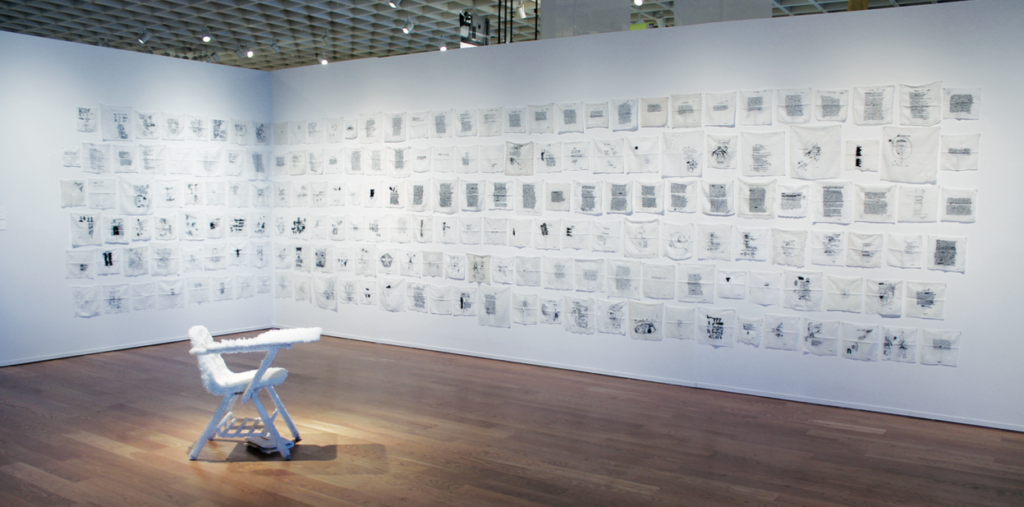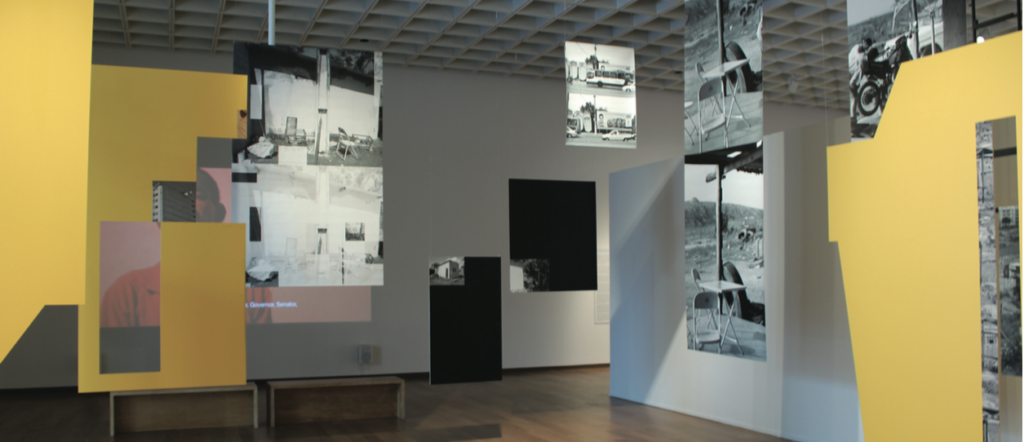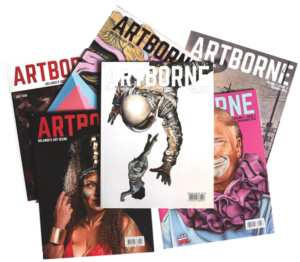The Florida Prize in Contemporary Art, now in its third year, is an initiative of the Orlando Museum of Art. The Florida Prize presents an exhibition of ten artists living and working in the state, with one artist selected as the winner of the prize. Through themes of technology and human geography, this year’s exhibition unites the diverse practices of Anthea Behm, Adler Guerrier, María Martínez-Cañas, Noelle Mason, Ernesto Oroza, Matt Roberts, Dawn Roe, Kyle Trowbridge, Michael Vasquez and Sergio Vega. Noelle Mason, from Tampa, was named this year’s prize winner.
Noelle Mason presented selections from two bodies of work for the show: Human Hunting (small, cotton stitcheries and large, wool tapestry-rugs examining the effects of vision technologies on perceptions of undocumented immigrants) and Love Letters/White Flag (vintage white handkerchiefs embroidered with entries from the journals of Eric Harris, one of the two students responsible for the 1999 Columbine High School shooting). Both bodies of work employ two-dimensional, appropriated imagery presented as three-dimensional textile objects created through processes associated with craft, domesticity, and the handmade. Mason’s use of these specific images implicates the power dynamic of surveillance in conditions of institutional dehumanization and objectification, from the American education system to immigration enforcement. The warmth of labor and craft juxtaposed with the eerie coldness of Mason’s imagery imposes a sense of discord in the simultaneous visibility and distance created by the use of visualization technologies.
The relevance and ubiquity of these technologies in our contemporary experience is paralleled throughout the show, in the work of other artists as well as in the name of the galleries. Two of the galleries containing the Florida Prize show are, ironically, named after museum sponsor Lockheed Martin, one of the companies responsible for the development of the technologies Mason takes her imagery from.
The effects of technology on human perception and experience is a theme also found in the work of nominees Kyle Trowbridge, Matt Roberts, Anthea Behm and Dawn Roe. Trowbridge’s saturated and colorful QR codes painted on canvas reveal playful hidden messages when scanned with a smartphone. Matt Roberts’ downloadable app The Strangers (a collaboration with poet and Stetson University professor Terri Witek) allows visitors to get to “unknow” items in the museum’s permanent collection by viewing the digitally altered works through their smartphone’s camera. Selected works in the collection prompt different augmented experiences, such as an out-loud reading of the question and answer: “What has been combed out of the body? The devil of day.” Anthea Behm’s humorous, single channel video Adorno/Bueller takes the viewer on a tour of the Art Institute of Chicago. The tour is narrated by changing tour guides reciting a garbled script composed of lines from Theodor Adorno’s Aesthetic Theory and the titular character’s monologue from Ferris Bueller’s Day Off. Dawn Roe’s Mountainfield Study dual channel video and photographic pigment prints are sublime ruminations on incongruities between visual experiences and photographs. The large-scale, dizzying video landscapes taken in Iceland and Canada are spliced and edited with mundane objects and textures such as aluminum foil and cheesecloth, causing the viewer to momentarily question the truth of visual perception through photo and video.
A sensitivity to geography, the landscape, and how humans interact with each other and these things in the world, is a common thread uniting works by Adler Guerrier, Sergio Vega, and Ernesto Oroza. Guerrier’s map-like folded-then-unfolded compositions of layered elements (frequently photo, paint, and graphite) were created through processes beginning with “deliberate travel”. The walls behind the compositions are painted in a mural-like fashion in the pastel color palettes of the urban Miami landscape. Sergio Vega’s video Paradise: Rewired presents itself as a nature documentary, complete with a dry, British narrator, exploring the Mato Grasso region in Brazil, an area previously associated with myths of Eden.
Poignant contemporary conditions of poverty and environmental degradation provide a stark backdrop of reality to the 17th-century discussions of Eden in Mato Grasso. Ernesto Oroza’s multi-faceted installation investigates ingenuity in improvised, modified, and repurposed architecture and material culture in Havana, Cuba. Covering a wall floor to ceiling are repeated tabloid-style publications in which Oroza describes the social and economic conditions in Havana leading to a culture of improvisation and re-use. A stack of the same publication is available as a takeaway. Two vitrines display small items, modified trash repurposed for use, and include a soda can lantern and recycled plastic sandals. A vintage carousel slide projector continuously cycles through a slideshow of photographs Oroza took in Havana titled Architecture of Necessity. Each mechanical click reveals another architectural adaptation, stunningly composed and documented by Oroza.
María Martínez-Cañas and Michael Vasquez both modify and distill pre-existing documentation of experience. Martínez-Cañas experiments with various photographic processes, including modification of found family photographs in her Vestigios series. Vasquez’s large, figural paintings – based on photographs of his own friends and acquaintances – explore visual, bodily displays of gang culture.
The artists in this year’s show present a nuanced and multidimensional understanding of contemporary conditions. The themes of technology and geography prompt consideration of humankind’s relationship with environmental forces. How do we shape our environment? How does our environment shape us? How do our perceptions of the world affect our actions within the world?
The exhibition runs until August 14, 2016 at the Orlando Museum of Art, 2416 North Mills Avenue, Orlando.



Hola! I’ve been following your web site for a long time now and finally got the courage to go ahead and give you a shout out from Porter Texas! Just wanted to say keep up the good job!